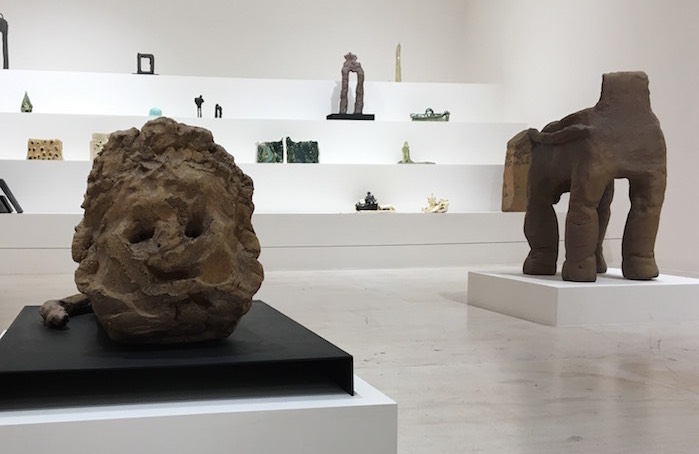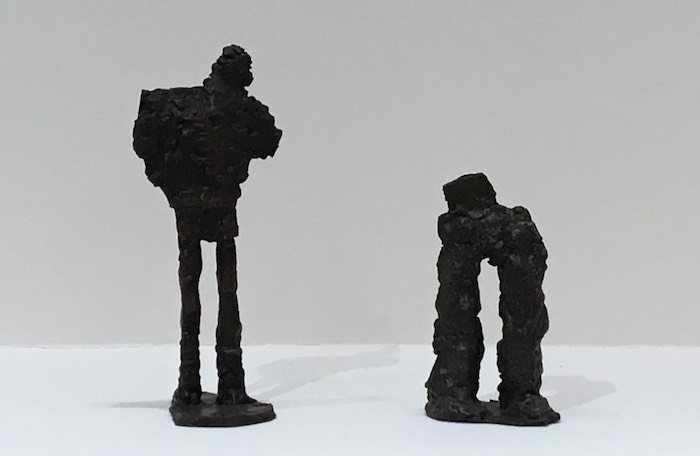News & Views
Works and Days: Simone Fattal at MoMA PSI
Strength and fragility come to the fore in the Syrian-Lebanese artist’s mythology-laden retrospective, writes Michael Hornsby

Photograph: Michael Hornsby
In the first room of Works and Days, we meet a lion. It lies legless on a flattened torso, low to the ground on a small plinth. Its face and mane show indentations by the artist’s fingers and thumbs in the brown clay, which has taken on a golden hue at the edges as it was fired in the kiln. The sensitivity of the rendering of an archetypical symbol of strength – a supporting character in so many a tale of heroism – sets up one of the most striking themes of the exhibition: delicacy and fragility amidst humanity’s most abiding stories. .
Born in Damascus and raised in Lebanon, Fattal studied philosophy at the Sorbonne before beginning to work as a visual artist in Beirut in the late 1960s. Moving to California in 1980, she founded the Post-Apollo Press, a publishing house dedicated to innovative and experimental literary work. She also developed a long-standing interest in Islamic mysticism, and Sufi poetry; the Press recently published a new translation of Ibn ʿArabī’s, Interpreter of Desires translated by Michael Sells (See our recent article). In 1988, she enrolled in a course at the Art Institute of San Francisco, which prompted a return to her artistic practice and a newfound dedication to sculpture and ceramics. This retrospective exhibition, at the prestigious MoMA PSI in New York, features over 200 pieces produced over the last fifty years, including, alongside the ceramics, paintings, watercolours, and collages.
PS1’s framing of the exhibition highlights the theme of displacement, and the epics and myths of the troubled region in which Fattal was born and raised. As the press release explains:
Never far from the earth, [Fatttal’s] works emerge as an unfinished project of telling the stories of ancient history with figures taken from central references such as The Epic of Gilgamesh, The Odyssey, Dhat al-Himma, and others. Both timeless and specific, her work straddles the contemporary, the archaic, and the mythic.
Throughout the exhibition, smaller sculptural works are arranged on stage-like platforms themed around the legends named above, as if the curator was assembling a cast of characters, or a landscape, from one of these stories. This approach helps the visitor make sense of Fattal’s enormous body of work, though, unfortunately, at times this comes at the cost of accessing some of the pieces more easily in their own right.

Sculpture of Adam and Eve. Photograph: Michael Hornsby
Back in the first room, behind the lion, more than a dozen smaller pieces stand on a terraced platform. A wall text draws attention to Adam and Eve, Fattal’s first clay piece and her first sculpture (apart from a piece of pink alabaster found in Lebanon during Arab-Israeli war, which she chiselled into an abstract representation of a human torso).
One might assume that it was the ordered thinking of a philosopher that led Fattal to choose as the subject of her first clay sculptures the first man and woman in the monotheistic creation myth, formed – according to the story in the Qurān – by God out of clay. Surprisingly, however, Fattal tells me by email that “it was certainly not a conscious decision.” Nonetheless the form of these pieces – inspired by Islamic mystical writings that portray the first prophet as a very tall person – defined a characteristic style for her figures. “I proceeded to make him tall, and in order to give this impression I made him with very tall legs, and a spare torso. And therefore this informed all the standing figures which came later,” she explains.
This form creates an impression of presence but not of strength, or other typical heroic attributes like courage or wisdom. It is as if Fattal is emphasizing the sheer existence of the figure rather than any particular characteristic: a heart standing on the earth, perhaps.
A notable feature is the rough, almost unfinished, appearance in many of the pieces. Fattal writes:
I work very hard to attain for my pieces the point of equilibrium, in which they will sustain standing up… When I reach this equilibrium, I have to stop touching them, because they will lose their balance. And therefore the traces of hands stay. After that they have to dry and then be taken to the kiln. In this journey, how many pieces did I lose, for they are most brittle and fragile!
A film recorded by Fattal in 1971 plays in a small theatre downstairs. It is a ‘self-portrait’ made on camera by the artist – who at the time was a painter – to capture, she says, more of the person than a canvas can support. In one sequence, Fattal and her family talk about the bombing of their neighbourhood during the Arab-Israeli war. Her father was thrown from the balcony of their apartment by an explosion. The women telling the story collapse into fits of laughter. Viewed after the sculptures and paintings upstairs, the moment draws a powerful connection between heroism and fragility, displacement and strength. Caught themselves in the middle of an epic struggle, Fattal and her family remain fully present.
“Van Gogh and Rembrandt, the greatest self-portraits artists in history, have both made numerous self-portraits… they thought no one piece was sufficient,” Fattal writes. In her own film, which was edited into a finished piece in 2012, she says: “I would have liked to have said some things differently, or shown more images…. But I have no desire to make another one, for instance one of me now… I have the impression of having said it all.”
Works and Days is at MoMA PSI until September 2nd, 2019. Click here for further information.
Sources (click to open)
Michael Hornsby is a writer and communications specialist based in Berlin.
More News & Views
Thich Nhat Hanh & the Poetry of Engaged Buddhism
Philip Brown presents the poem ‘Recommendation’ and comments on the potential of contemplative art to foster compassion
Introducing… ‘Perfect Days’ and ‘Nowhere Special’
Jane Clark watches two films with a contemplative theme
Irreducible: Consciousness, Life, Computers and Human Nature
Richard Gault reviews a new book by one of the leading lights of the science of consciousness
An Irish Atlantic Rainforest
Peter Mabey reviews a new book by Eoghan Daltun which presents an inspiring example of individual action in the face of climate change
In Memory of Bill Viola (1951–2024)
Jane Carroll pays tribute to the acclaimed video artist, who died on July 12th 2024
Bringing More Land Back to Life
Luci Attala gives an update on the Kogi’s exciting regeneration project, Munekan Masha, in Colombia
FOLLOW AND LIKE US
——————————————
——————————————
——————————————
If you enjoyed reading this article
Please leave a comment below.
Please also consider making a donation to support the work of Beshara Magazine. The magazine relies entirely on voluntary support. Donations received through this website go towards editorial expenses, eg. image rights, travel expenses, and website maintenance and development costs.
READERS’ COMMENTS
FOLLOW AND LIKE US
0 Comments